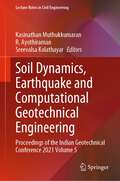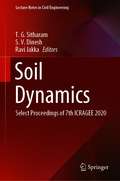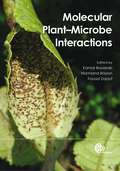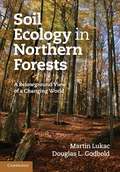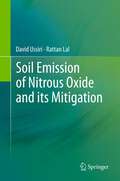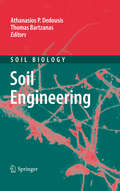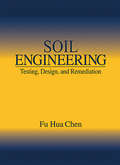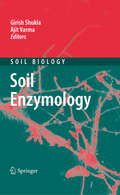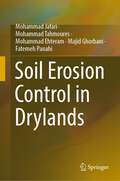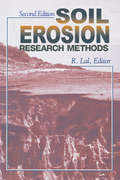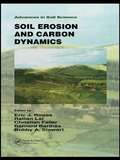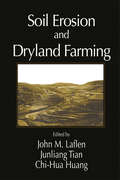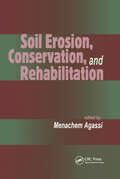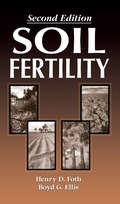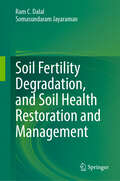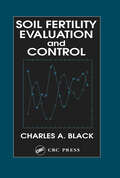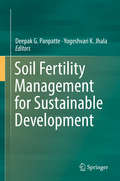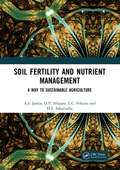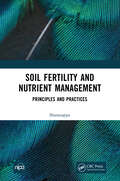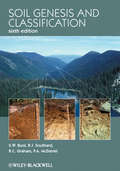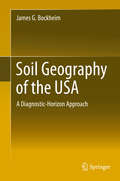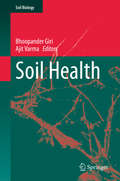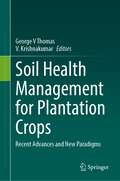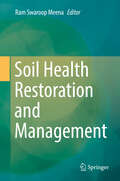- Table View
- List View
Soil Dynamics, Earthquake and Computational Geotechnical Engineering: Proceedings of the Indian Geotechnical Conference 2021 Volume 5 (Lecture Notes in Civil Engineering #300)
by Sreevalsa Kolathayar Kasinathan Muthukkumaran R. AyothiramanThis book comprises the select peer-reviewed proceedings of the Indian Geotechnical Conference (IGC) 2021. The contents focus on Geotechnics for Infrastructure Development and Innovative Applications. The book covers topics related to parameters of soil, liquefaction evaluation of subsoil strata, analysis of earth and development of shear wave velocity profile, seismic hazard analysis, vibration isolation methods, application of machine learning in geotechnical engineering, among others. This volume will be of interest to those in academia and industry.
Soil Dynamics: Select Proceedings of 7th ICRAGEE 2020 (Lecture Notes in Civil Engineering #119)
by T. G. Sitharam S. V. Dinesh Ravi JakkaThis volume presents select papers presented at the 7th International Conference on Recent Advances in Geotechnical Earthquake Engineering and Soil Dynamics. The papers discuss advances in the fields of soil dynamics and geotechnical earthquake engineering. A strong emphasis is placed on connecting academic research and field practice, with many examples, case studies, best practices, and discussions on performance based design. This volume will be of interest to researchers and practicing engineers alike.
Soil Ecology and Management
by Joann Whalen Luis SampedroSoil ecology is the study of interactions between the physio-chemical components of the soil and organisms living within the soil. Humans are highly dependent upon the soil ecosystem, which provides food, fiber, fuel and ecological services, such as the recycling of atmospheric gases. It is therefore important to understand the function and nature of the soil ecosystem in order to predict and mitigate the long term consequences of present day actions. Soil Ecology and Management describes the organisms inhabiting the soil, their functions and interactions and the dimensions of human impact on the activity of soil organisms and soil ecological function. Chapters discuss basic soil characteristics and biogeochemical cycling, key soil flora and fauna, community-level dynamics (soil food webs) and the ecological and pedological functions of soil organisms. Unlike other soil biology and ecology textbooks, the authors also convey a better understanding of how human activities impact upon soil ecology in a section on ecosystem management and its effects on soil biota and provide a unique perspective on the utility of soil organisms.
Soil Ecology in Northern Forests
by Martin Lukac Douglas L. GodboldForest soils form the foundation that underpins the existence of all forests. This book encapsulates soil ecology and functioning in northern forests, focusing on the effects of human activity and climate change. The authors introduce the fundamental principles necessary for studying forest soils, and explain the functioning and mutual influence of all parts of a forest soil ecosystem. A chapter is dedicated to each of soil acidity and heavy metal pollution, elevated carbon dioxide, nitrogen deposition and climate change, highlighting the most important anthropogenic factors influencing forest soil functioning and how these soils are likely to respond to environmental change. With its unique view of the functioning of the soils found under temperate and boreal forests in today's rapidly changing world, this book is of interest to anyone studying forestry and forest ecology in European, North American and North Asian contexts.
Soil Emission of Nitrous Oxide and its Mitigation
by Rattan Lal David UssiriNitrous oxide gas is a long-lived relatively active greenhouse gas (GHG) with an atmospheric lifetime of approximately 120 years, and heat trapping effects about 310 times more powerful than carbon dioxide per molecule basis. It contributes about 6% of observed global warming. Nitrous oxide is not only a potent GHG, but it also plays a significant role in the depletion of stratospheric ozone. This book describes the anthropogenic sources of N2O with major emphasis on agricultural activities. It summarizes an overview of global cycling of N and the role of nitrous oxide on global warming and ozone depletion, and then focus on major source, soil borne nitrous oxide emissions. The spatial-temporal variation of soil nitrous oxide fluxes and underlying biogeochemical processes are described, as well as approaches to quantify fluxes of N2O from soils. Mitigation strategies to reduce the emissions, especially from agricultural soils, and fertilizer nitrogen sources are described in detail in the latter part of the book.
Soil Engineering
by Athanasios P. Dedousis Thomas BartzanasThe agricultural world has changed significantly during the last years. The excessive use of heavy machinery, waste disposal, the use of agrochemicals and new soil cultivation means led to severe problems, which agricultural engineers have to cope with in order to prevent soil from permanent irreversible damage. This Soil Biology volume will update readers on several cutting-edge aspects of sustainable soil engineering including topics such as: soil compaction, soil density increases, soil disturbance and soil fragmentation; soil tillage machineries and optimization of tillage tools; soil traffic and traction, effects of heavy agricultural machines, the use of robotics in agriculture and controlled traffic farming; mechanical weed control, the characterization of soil variability and the recycling of compost and biosolids in agricultural soils.
Soil Engineering: Testing, Design, and Remediation
by Fu Hua ChenIn the last forty years, at least fifty books have been written on the subject of soil mechanics, most of them textbooks. Only a few touch on practical applications. Soil Engineering: Testing, Design, and Remediation supplies the information needed to fill the gap between textbook learning and practical know-how. When engineers deal with major p
Soil Enzymology
by Ajit Varma Girish ShuklaSoil enzymes are one of the vital key mediators involved in nutrient recycling and the decomposition of organic matter and thereby in maintaining soil quality and fertility. This Soil Biology volume covers the various facets of soil enzymes, such as their functions, biochemical and microbiological properties and the factors affecting their activities. Enzymes in the rhizosphere, in forest soils, and in volcanic ash-derived soils are described. Soil enzymes covered include phosphohydrolases, lignocellulose-degrading enzymes, phenol oxidases, fungal oxidoreductases, keratinases, pectinases, xylanases, lipases and pectinases. Several chapters treat the soil enzymatic activities in the bioremediation of soils contaminated with pesticides and pollutants such as oil, chlorinated compounds, synthetic dyes and aromatic hydrocarbons. The role of soil enzymes as bioindicators is a further important topic addressed.
Soil Erosion Control in Drylands
by Mohammad Jafari Fatemeh Panahi Majid Ghorbani Mohammad Tahmoures Mohammad EhteramThis book focuses on drylands such as arid, semi-arid and dry sub-humid areas where they form the main part of ecosystems, e.g., in Iran, but also around the world. Mismanagement and improper exploitation of these areas lead to more degradation day by day. Besides an introduction to the role and importance of vegetation cover in conserving soil against wind and water erosion, this book gives a scope of appropriate techniques and methods for vegetation establishment and maintenance, indicators for suitable plants selection for soil conservation, and soil erosion prevention and combat. It provides methods of soil erosion prevention and combating through the application of plants, using bioengineering systems for soil erosion control and the role of agroforestry in soil erosion prevention. This book can be helpful to those with an interest in countries with similar climates to Iran. In particular, this includes Dubai, Kuwait, Saudi Arabia, Afghanistan, and Pakistan.
Soil Erosion Research Methods
by Soil and Water Conservation Society (U. S.)This new edition of Soil Erosion Research Methods retains the themes and layout of the first edition. However, most chapters have been revised and some additional chapters have been added. There are new chapters on modeling wind and water erosion. Extensive revisions and updating have been done in chapters dealing with assessment of erosivity and erodibility, erosion, crop productivity, measuring sediment yield from river basins and field plot techniques. There is extensive updating of current statistics on the global magnitude of soil erosion by water and wind and on denudation rates. Several new authors have made significant improvements in revising and updating available information.
Soil Erosion and Carbon Dynamics (Advances In Soil Science Ser. #Vol. 15)
by Eric J. RooseThe most complete, nonpartisan source of information on this hot agronomic topic available today, this book brings together a diverse group of papers and data to resolve the debate between sedimentologists and soil scientists and agronomists over whether the effects of soil erosion on carbon and atmospheric CO2 is beneficial or destructive. Divided into four sections, it offers data on how soil erosion affects soil, water, and air quality. Topics include mineralization rate, inundation, sediment deposition, and global warming potential, as well as carbon dioxide, methane, and nitrous oxide emissions, and the implications of soil erosion on the global carbon cycle and carbon budget.
Soil Erosion and Dryland Farming
by Junliang Tian Chi-Hua Huang John M. Laflen"I've seen the Sudan, traveled in South and Central America and been all over Europe, but I've never seen what I've been able to see on this tour [of the Loess Plateau, China]."-Ed Skidmore, soil scientist, WindErosion Research Unit of the Agricultural Research Service, USDA, Manhattan, KansasOverpopulation is at the core of most en
Soil Erosion, Conservation, and Rehabilitation
by Agassi,Discusses the latest information regarding the processes and mechanisms responsible for runoff and erosion by water in arable lands--detailing state-of-the-art water and soil conservation methods. Elucidates the rehabilitation of agricultural lands depleted by human activity.
Soil Fertility
by Boyd Ellis Henry FothSoils are one of the world's most important resources, and their protection, maintenance, and improvement is critical to the continuance of life on earth. Soil Fertility, Second Edition, offers thorough coverage of the fertility, composition, properties, and management of soils. This book carries on the tradition of excellence established by authors Henry Foth and Boyd Ellis, leading soil scientists whose previous books in this field have become multi-edition classics.The Second Edition of Soil Fertility has been significantly expanded to include more information on mineralogy, while keeping the thorough coverage of essential topics. The book presents soils as dynamic, constantly changing bodies, and relates soil fertility and management to the mineralogy of their origin. Four new chapters offer updated information on soil charge properties, ion adsorption, exchange and fixation, and soil reaction. There is also a far greater emphasis on environmental issues, reflecting the increasing importance of environmental concerns to agronomists and soil scientists today.
Soil Fertility Degradation, and Soil Health Restoration and Management
by Ram C. Dalal Somasundaram JayaramanThis monograph provides a comprehensive collection of information on soil fertility degradation across various climatic zones and soil orders. It focuses on physical, chemical, and biological degradation of soil, offering insights into sustainable soil management practices for restoring degraded soils. The book details the processes and causes of soil degradation, including structural degradation, erosion, nutrient depletion, nutrient mining, decline of soil organic matter, and biological degradation, while highlighting strategies to mitigate and remediate these issues in different climatic zones. Unsustainable farming practices have accelerated soil degradation globally, leading to soil erosion, nutrient loss, and structural damage. Nutrient depletion and the loss of soil organic carbon are among the most critical concerns, but these trends can be reversed with sustainable management practices and appropriate technologies. This book addresses the challenges of fertility-degraded soils and offers wide range of management and restoration strategies to ensure food and nutritional security, maintain ecosystem services, and attain Sustainable Development Goals under various agro-climatic conditions worldwide. This book is a valuable reference material for researchers, scientists, students, farmers, and land managers seeking efficient and sustainable natural resource management. It also serves as essential reading material for undergraduate and postgraduate students in agriculture, soil science, agronomy, agrophysics, agrobiology, and environmental and climate sciences.
Soil Fertility Evaluation and Control
by Charles A. BlackSoil Fertility Evaluation and Control presents the theoretical background for practical applications of scientific work on soil fertility. The book emphasizes the use of response curves as the basic biological standard for both evaluation and control, and it discusses soil testing and plant analysis as secondary standards. The principal application
Soil Fertility Management for Sustainable Development
by Deepak G. Panpatte Yogeshvari K. JhalaSoil fertility is the backbone of agricultural systems and plays a key role in determining food quantity and quality. In recent decades, soil fertility has decreased due to indiscriminate use of agrochemicals, and nations around the globe are now facing the challenge of increasing food production while sustainably maintaining soil fertility. Written by leading international scientists in the field, this book explores soil fertility management strategies, including agronomic, microbiological and soil-science based strategies. Highlighting the practices that can be incorporated into organic farming and discussing recent advances, it is a valuable resource for researchers wanting to broaden their vision and the scope of their investigations.
Soil Fertility and Nutrient Management: A Way to Sustainable Agriculture
by A.S. Jadeja D.V. Hirpara L.C. Vekaria H.L. SakarvadiaThe book entitled Soil Fertility and Nutrient Management is a compilation work and most of the information was farmed very critically covering all the main topics of plant nutrition. The book will be serve as useful reference to students, teachers, researchers scientists, policy makers and other interested in soil science, agronomy, crop science, environmental sciences and agriculture. Note: T&F does not sell or distribute the Hardback in India, Pakistan, Nepal, Bhutan, Bangladesh and Sri Lanka.
Soil Fertility and Nutrient Management: Principles and Practices
by SharanappaUnderstanding of the dynamics of plant nutrients in the soil provides scientific basis for efficient nutrient management. Soil organic matter not only provides the nutrients required by the crop but also improve the biological and physical properties of the soil. This book collects and discusses information on production and management of organic manures, biofertilizers, integrated nutrient management in cropping systems and nutrient management in problematic soils. Print and electronic editions not for sale in South Asia (India, Sri Lanka, Nepal, Bangladesh, Pakistan, Afghanistan and Bhutan).
Soil Genesis and Classification
by Stanley W. Buol Randal J. Southard Robert C. Graham Paul A. McDanielSoil Genesis and Classification, Sixth Edition, builds on the success of the previous editions to present an unparalleled resource on soil formation and classification. Featuring a color plate section containing multiple soil profiles, this text also includes information on new classification systems and emerging technologies and databases with updated references throughout. Covering the diverse needs of both the academic and professional communities, this classic text will be a must have reference for all those in soil science and related fields.
Soil Geography of the USA
by James G. BockheimSince 1980, our understanding of the factors and processes governing the distribution of soils on the Earth's surface has increased dramatically, as have the techniques for studying soil patterns. The approach used in this book relies on the National Resources Conservation Service databases to delineate the distribution of each of the eight diagnostic epipedons and 19 subsurface horizons, to identify the taxonomic level at which each of these horizons is used, to develop an understanding of the role of the factors and processes in their formation and to summarize our latest understanding of their genesis. A chapter is devoted to each diagnostic horizon (or combined horizons). This book is intended to serve as a textbook in soil geography, a reference book for geographers, ecologists and geologists and a tool for soil instructors, landlookers, mappers, classifiers and information technologists.
Soil Health (Soil Biology #59)
by Ajit Varma Bhoopander GiriThis book gathers the latest insights into soil health and its sustainability, providing an up-to-date overview of the various aspects of soil quality and fertility management, e.g., plant-microbe interactions to maintain soil health; and the use of algal, fungal and bacterial fertilizers and earthworms for sustainable soil health and agricultural production.It first discusses the past, present, and future scenarios of soil health, and then explores factors influencing soil health, as well as the consequences of degradation of soil health for sustainable agriculture. Lastly it highlights solutions to improve and maintain soil health so as to achieve greater productivity and sustainability without damaging the soil system or the environment.Soil health is defined as the capacity of a soil to function within ecosystem frontiers, to sustain biological productivity, to maintain environmental quality and to promote plant, animal and human health. Soil health is established through the interactions of physical, chemical and biological properties, e.g., soil texture, soil structure, and soil organisms. Healthy soil provides adequate levels of macro- and micronutrients to plants and contains sufficient populations of soil microorganisms. As a result of the increasingly intensified agriculture over the past few decades, soils are now showing symptoms of exhaustion and stagnating or declining crop yields. Exploring these developments as well as possible solutions based on holistic and sustainable approaches, this book is a valuable resource for researchers in the area of soil and environmental science, agronomy, agriculture, as well as students in the field of botany, ecology and microbiology.
Soil Health Analysis, Set (ASA, CSSA, and SSSA Books)
by Douglas L. Karlen Diane E. Stott Maysoon M. MikhaVolume 1 briefly reviews selected &“Approaches to Soil Health Analysis&” including a brief history of the concept, challenges and opportunities, meta-data and assessment, applications to forestry and urban land reclamation, and future soil health monitoring and evaluation approaches.Volume 2 focuses on &“Laboratory Methods for Soil Health Analysis&” including an overview and suggested analytical approaches intended to provide meaningful, comparable data so that soil health can be used to guide restoration and protection of our global soil resources.
Soil Health Management for Plantation Crops: Recent Advances and New Paradigms
by V. Krishnakumar George V ThomasThis edited volume elucidates state-of-the-art information and provides new paradigms of soil health-based pathways for sustaining plantation crops and diversified systems. The book covers soil characteristics, soil fertility constraints, issues of soil contamination, the impact of climate change on plantation soils, indicators of soil health and soil health assessment, fertility management for healthy soils, soil amendments, soil biodiversity, and biological functions and micro-biome as well as meta-genomic approach.Plantation crops are perennials, cultivated in tropical and sub-tropical agroecosystems in a contiguous area, and comprise estate crops which include tea, coffee, and rubber and small holders’ plantation crops such as coconut, areca nut, oil palm, cashew, cocoa, and spices. These are high-value crops with considerable significance in livelihood security, commerce, and trade, and are grown in ecologically vulnerable regions such as coastal belts, hilly areas, andregions with high rainfall and high humidity, which makes maintenance of soil health a major challenge. Sustainable agricultural production depends on the health, quality, and functionality of the soil. The book includes technological options to achieve sustainable production encompassing soil health improvement through multi-strata, multi-species cropping systems, integrated farming systems, conservation agriculture practices, cover cropping and green manuring, crop residue recycling, bio-fertilizer and bio-stimulant technologies and organic farming systems.This book is an essential resource for researchers, plantation professionals, educators, and policymakers. It provides valuable insights and practical solutions for addressing emerging issues in soil health management and is a must-read for students of agriculture, forestry, ecology, microbiology, soil science, and environmental sciences.
Soil Health Restoration and Management
by Ram Swaroop MeenaMeeting the food requirements of an ever-increasing population is a pressing challenge for every country around the globe. Soil degradation has a negative impact on food security by reducing the cultivated land areas, while at the same time the world population is predicted to increase to 9.2 billion in 2050. Soil degradation adversely affects soil function and productivity and degraded soils now amount to 6 billion ha worldwide. The major factors are salinization, erosion, depletion of nutrients due to exhaustive agricultural practices and contamination with toxic metal ions and agrochemicals, which reduces the activity of soil microbe. In addition, poor soil management also decreases fertility. As such, measures are required to restore the soil health and productivity: organic matter, beneficial microorganisms and nutrient dynamics can all improve the physical, chemical and biological properties of soil. Understanding the role of soil health restoration and management in sustainability and nutritional security calls for a holistic approach to assess soil functions and examine the contributions of a particular management system within a defined timescale. Further, best management practices in cropping systems are important in ensuring sustainability and food and nutritional security without compromising the soil quality and productivity potential. Rational soil management practices must allow environmentally and economically sustainable yields and restoration of soil health.
